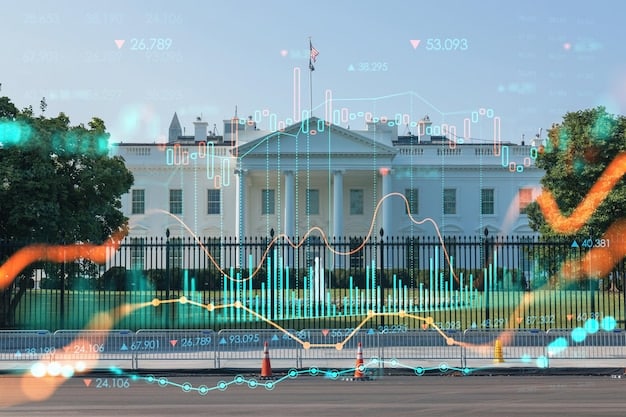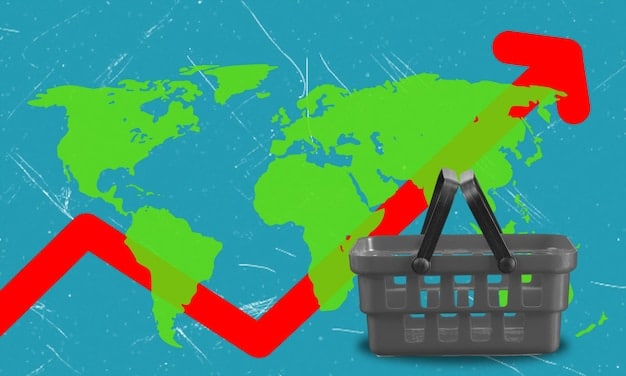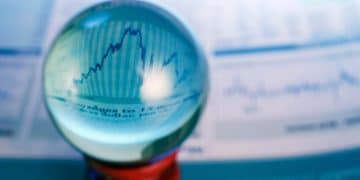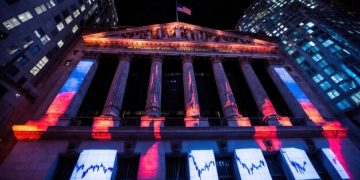Decoding Fed Rate Hike: Impact on US Businesses

The Federal Reserve’s latest interest rate hike significantly impacts US businesses by increasing borrowing costs, influencing consumer spending, and reshaping investment landscapes, necessitating strategic financial adjustments and forward-thinking planning.
Understanding the intricacies of monetary policy directly impacts your business’s bottom line. The recent decision to raise interest rates by the Federal Reserve, a move subject to intense scrutiny, carries profound implications across the American economic fabric. This article aims at decoding the latest Federal Reserve rate hike: what it means for US businesses, providing clarity on its immediate and long-term effects.
understanding the federal reserve’s role
The Federal Reserve, often referred to as the Fed, stands as the central banking system of the United States. Established in 1913, its primary mandate centers around maintaining price stability, maximizing employment, and moderating long-term interest rates. These three objectives form the cornerstone of its dual mandate, guiding every policy decision.
Its structure is complex, comprising a Board of Governors, twelve Federal Reserve Banks, and the Federal Open Market Committee (FOMC). The FOMC is particularly relevant as it is the principal body responsible for setting monetary policy, including interest rates. Through open market operations, adjustments to the discount rate, and setting reserve requirements, the Fed influences the availability and cost of money and credit in the economy.
Historically, the Fed has leveraged these tools to navigate economic cycles. During recessions, it typically lowers rates to stimulate borrowing and investment, thereby boosting economic activity. Conversely, in periods of inflation or overheating, it raises rates to curb spending and cool down the economy. The recent rate hike stems from this latter scenario, a response to persistent inflationary pressures that have impacted everything from consumer goods to raw materials.
It’s crucial for businesses to understand that the Fed operates with a degree of independence from political pressure. This independence is designed to allow it to make difficult, unpopular decisions when necessary for the long-term health of the economy, even if those decisions might have short-term political ramifications. This autonomy contributes to its credibility and effectiveness in its mission.
Ultimately, the Fed’s actions send powerful signals to financial markets and economic actors. A rate hike, for instance, signals the Fed’s commitment to fighting inflation, even if it introduces some headwinds for economic growth. This understanding is foundational for any business attempting to forecast its operating environment and financial strategies.
the mechanics of a rate hike
When the Federal Reserve decides on a rate hike, it specifically adjusts the federal funds rate. This isn’t a direct rate that consumers or businesses pay, but rather the target rate for overnight lending between banks. While seemingly niche, changes to this rate ripple throughout the entire financial system, affecting virtually every other interest rate.
How does this ripple effect occur? It begins with the banks. When the federal funds rate increases, it becomes more expensive for banks to borrow from each other to meet their reserve requirements. To compensate for these higher costs, banks typically pass them on to their customers in the form of higher interest rates on loans across the board.
prime rate and beyond
The most immediate impact is usually seen in the prime rate, which is the interest rate commercial banks charge their most creditworthy corporate customers. The prime rate almost always moves in lockstep with changes in the federal funds rate. From there, it influences consumer loans like credit cards, auto loans, and adjustable-rate mortgages. For businesses, this means higher costs for revolving lines of credit, term loans, and even equipment financing.
* Higher Borrowing Costs: Businesses reliant on debt financing for expansion, working capital, or asset acquisition will face increased expenses.
* Credit Card Rates: Small businesses using business credit cards for operational expenses will see their interest payments rise.
* Variable-Rate Loans: Any existing business loan with a variable interest rate will become more expensive to service.
* Mortgage Rates: Commercial real estate mortgages, particularly those with adjustable rates, will see their payments increase.
Beyond specific loan products, a rate hike can also influence investment decisions. As risk-free assets like Treasury bonds offer higher returns, investors may shift capital away from riskier ventures, including private equity and venture capital funding for businesses. This can make it harder for startups and growth-stage companies to secure funding, thereby slowing innovation and expansion.
Moreover, the mechanism extends to global markets. A stronger US dollar, often a consequence of higher interest rates, can make US exports more expensive for foreign buyers, potentially dampening international demand for American goods and services. This complex interplay underscores why businesses need to delve beyond the headlines and understand the deeper financial mechanics at play.
impact on business borrowing and investment
The direct consequence of a Federal Reserve rate hike for US businesses manifests most acutely in their borrowing and investment strategies. Higher interest rates translate immediately into higher costs for accessing capital, impacting both existing debt and future financing plans.
For businesses with variable-rate loans, such as lines of credit or certain forms of commercial mortgages, debt service costs will increase. This means a larger portion of revenue must be allocated to interest payments, potentially reducing cash flow available for operations, expansion, or shareholder returns. Companies with significant variable-rate debt may find their profit margins squeezed, particularly if they operate in industries with tight margins.
New borrowing also becomes more expensive. Businesses planning capital expenditures, such as purchasing new equipment, expanding facilities, or investing in research and development, will face higher financing costs. This can lead to a re-evaluation of project viability. Projects that were marginally profitable under lower interest rate regimes might no longer meet internal rate of return (IRR) thresholds, leading to postponements or cancellations of investments.
* Delayed Expansion Plans: Businesses might put off plans for new factories, offices, or significant equipment upgrades.
* Increased Debt Service: Companies with existing floating-rate debt will see their interest payments rise, impacting cash reserves.
* Reduced M&A Activity: Higher financing costs can make mergers and acquisitions less attractive, slowing down industry consolidation.
* Value Recalibration: Valuations of businesses, especially those reliant on future earnings discounted at higher rates, may decrease.
The investment landscape for businesses also shifts. For startups and small and medium-sized enterprises (SMEs) relying on venture capital or angel investments, higher interest rates make it more challenging to attract funding. Investors, now able to achieve better returns on less risky assets like government bonds, may demand higher potential returns from riskier private investments, making it harder for these businesses to raise capital and grow.
Furthermore, consumer spending, a key driver for many businesses, can also be affected. As consumers face higher costs for credit card debt, auto loans, and mortgages, their disposable income may shrink, leading to reduced demand for goods and services. Businesses in consumer discretionary sectors, like retail, hospitality, and entertainment, are particularly vulnerable to such shifts in consumer behavior. Understanding these intertwined dynamics is crucial for strategic planning.
consumer spending and demand management
The influence of a Federal Reserve rate hike extends well beyond the corporate balance sheet, deeply impacting consumer spending and, consequently, the demand for goods and services that US businesses rely upon. This trickle-down effect is a primary mechanism through which the Fed aims to control inflation.
When borrowing becomes more expensive for consumers, it directly deters them from taking on new debt for significant purchases. For instance, higher mortgage rates can cool down the housing market, leading to fewer home sales and, by extension, less demand for related industries like furniture, appliances, and home improvement services. Similarly, increased auto loan rates can reduce new car sales. Higher interest on credit cards can also lead consumers to reduce discretionary spending as their monthly debt obligations rise.
This reduction in consumer appetite for debt-fueled purchases is precisely what the Fed hopes to achieve. By making money more expensive, it aims to slow down overall economic activity, thereby reducing demand pressures that contribute to inflation. For businesses, this translates to a potential slowdown in sales.
sectors vulnerable to a slowdown
Certain sectors are more susceptible to shifts in consumer spending. Businesses in discretionary retail, such as fashion boutiques, electronics stores, and high-end goods, often feel the pinch first. The hospitality and travel industries might also see a decline in bookings as consumers tighten their belts.
* Retail Sales Slump: Non-essential goods and services often see reduced demand.
* Housing Market Cooling: Impacting real estate, construction, and related industries.
* Reduced Auto Sales: Higher loan costs deter new vehicle purchases.
* Decreased Service Demand: Leisure and entertainment sectors may experience lower patronage.
Conversely, businesses providing essential goods and services, such as grocery stores, utilities, and healthcare providers, tend to be more resilient during periods of tightened consumer spending. However, even these sectors can be affected by broader economic slowdowns if unemployment rises significantly.
Effective demand management by businesses in this environment involves understanding shifting consumer priorities. It might necessitate adjusting pricing strategies, offering promotions, or focusing on value-oriented products to maintain sales volumes. Businesses that can adapt quickly to these changing consumer behaviors will be better positioned to weather the economic headwinds induced by higher interest rates. This is not merely about surviving; it’s about strategically repositioning for future growth.

navigating supply chains and inflation
The recent Federal Reserve rate hike is primarily a tool to combat inflation, which has been significantly exacerbated by persistent supply chain disruptions. For US businesses, navigating the dual challenges of higher interest rates and ongoing supply chain volatility requires a nuanced approach.
While higher interest rates aim to cool demand, they don’t directly resolve supply-side issues such as component shortages, shipping delays, or labor scarcity. In fact, for businesses heavily reliant on complex global supply chains, the impact can be twofold: they face increased costs due to inflation-driven input prices, and higher borrowing costs to finance those more expensive inventories or production processes.
For some businesses, particularly manufacturers and logistics companies, the pressure from rising input costs like raw materials and energy could outweigh any slight softening of demand that occurs. They might also face higher costs for warehousing and transportation due to inflation, even as financing those operations becomes more expensive.
strategies for resilience
Businesses are increasingly adopting strategies to build more resilient supply chains in response to these pressures. This includes diversification of suppliers, bringing production closer to home (reshoring or nearshoring), and investing in technology to improve supply chain visibility and efficiency. However, these initiatives often require significant capital investment, which becomes more costly in a high interest rate environment.
* Supplier Diversification: Reducing reliance on a single source or region to mitigate risks.
* Reshoring/Nearshoring: Bringing manufacturing closer to the US to reduce transport costs and lead times.
* Inventory Management: Optimizing inventory levels to balance supply reliability with financing costs.
* Technology Adoption: Implementing AI and analytics for better forecasting and supply chain optimization.
The interplay between inflation and interest rates also affects pricing strategies. Businesses might be forced to pass on increased costs to consumers through higher prices, risking a reduction in sales volume if consumer demand softens too much due to the rate hikes. Alternatively, absorbing these costs can erode profit margins. Finding this balance is a critical challenge.
Ultimately, businesses must continually assess their exposure to supply chain vulnerabilities and inflationary pressures. This includes detailed cost analysis, robust inventory management, and strategic sourcing decisions. While the Fed’s actions tackle demand-side inflation, businesses must proactively manage the supply-side challenges that remain a significant factor in their operational costs. The period demands careful management of both financial and operational aspects.
strategic adjustments for businesses
In the wake of a Federal Reserve rate hike, US businesses must undertake strategic adjustments across various operational and financial realms to mitigate risks and identify new opportunities. Proactive planning is key to navigating this altered economic landscape.
One immediate area for review is finance management. Businesses should re-evaluate their debt portfolios. For those with significant variable-rate debt, exploring options to fix interest rates, if feasible, could provide stability. Optimizing working capital management becomes even more critical, focusing on efficient accounts receivable and payable processes to maximize cash flow and reduce reliance on expensive short-term borrowing.
Cost control must also be a priority. While this is always important, a higher interest rate environment intensifies the need to scrutinize all expenditures. This doesn’t necessarily mean cutting corners but rather identifying inefficiencies and areas where savings can be achieved without compromising quality or core operations. This could involve renegotiating vendor contracts, optimizing energy consumption, or streamlining internal processes.
re-evaluating growth strategies
Growth strategies need a realistic re-evaluation. While expansion is always desirable, projects that seemed viable when capital was cheap might no longer yield acceptable returns. Businesses should prioritize investments that promise immediate and tangible returns, those essential for competitive advantage, or those that enhance operational efficiency. This might involve focusing on organic growth through increased market share within existing segments rather than aggressive expansion into new markets.
* Scenario Planning: Develop multiple financial forecasts based on different interest rate scenarios.
* Liquidity Management: Maintain healthy cash reserves to cover operational costs and mitigate unexpected expenses.
* Capital Reallocation: Shift investments towards high-return, lower-risk projects.
* Customer Loyalty: Focus on retaining existing customers through superior service and value, as acquiring new customers may become more expensive.
For businesses looking to raise capital, traditional bank loans might become less attractive. Exploring alternative financing options, such as asset-backed lending, revenue-based financing, or even factoring receivables, could provide necessary liquidity without the higher interest burden of conventional loans.
Businesses also need to communicate effectively with stakeholders—investors, employees, and customers—about their strategies for managing the economic shifts. Transparency about challenges and proactive steps being taken can build confidence and foster resilience. The ability to adapt and pivot quickly will distinguish successful businesses in this challenging economic climate.

opportunity in economic shifts
While Federal Reserve rate hikes undeniably present challenges for US businesses, they also open doors for strategic opportunities. Shifting economic conditions necessitate adaptation, but they can also reward those prepared to innovate and capitalize on new dynamics.
One significant opportunity lies in market consolidation. Higher borrowing costs can place stress on weaker or overleveraged competitors. This might create opportunities for stronger, well-capitalized businesses to acquire struggling rivals at more favorable valuations, consolidating market share and expanding capabilities. Mergers and acquisitions, while more expensive to finance, can still present strategic advantages for resilient firms.
Innovation in efficiency is another key area. When capital is expensive, businesses are incentivized to find ways to do more with less. This can spur investment in automation, process optimization, and digital transformation initiatives that might have been less urgent in a low-interest-rate environment. Such investments can lead to long-term cost savings, improved productivity, and enhanced competitiveness.
attracting and retaining talent
The economic slowdown induced by rate hikes, while potentially leading to layoffs in some sectors, can also create a more favorable labor market for businesses seeking to hire skilled talent. As competition for jobs increases, employers might find it easier to attract and retain high-quality employees without feeling extreme wage pressures.
* Competitive Advantage: Stronger financial positions allow for strategic acquisitions of competitors or assets.
* Process Optimization: Investment in technology and automation reduces long-term operational costs.
* Talent Acquisition: A less competitive labor market offers opportunities to secure skilled employees.
* Market Repositioning: Identifying underserved niches or segments that emerge due to changing consumer behavior.
Furthermore, a period of economic tightening often encourages greater financial discipline within organizations. This newfound rigor, born out of necessity, can lead to more robust financial planning, more efficient resource allocation, and a stronger balance sheet in the long run. Businesses that emerge from such periods with leaner operations and sounder financial practices are often better positioned for future growth.
Lastly, some businesses may find niche opportunities as consumer spending patterns shift. For example, as value becomes a more significant consideration for consumers, businesses offering affordable alternatives or services that help consumers save money (e.g., repair services, budget-friendly options) may see increased demand. Recognizing and adapting to these evolving consumer needs can unlock new revenue streams. The key is to view these shifts not just as obstacles, but as catalysts for transformation and strategic advancement.
| Key Point | Brief Description |
|---|---|
| 💸 Borrowing Costs | Increased interest rates elevate the cost of business loans and lines of credit, impacting profitability. |
| 📉 Consumer Spending | Higher credit costs for consumers can lead to reduced discretionary spending and lower demand for non-essential goods. |
| 📈 Investment Decisions | Companies may delay or cancel capital expenditure projects due to higher financing expenses. |
| 💡 Strategic Adjustments | Businesses must focus on cost control, efficient working capital, and adapting growth strategies. |
Frequently Asked Questions
▼
The Federal Reserve typically raises interest rates to combat inflation. When prices are rising too quickly, increasing the cost of borrowing money helps to cool down economic activity, reduce demand, and bring inflation back to the Fed’s target level of around 2%. This move aims to stabilize the economy.
▼
Small businesses are often more sensitive to rate hikes. Higher rates increase the cost of loans for expansion, equipment, and working capital. This can squeeze profit margins, make it harder to secure new financing, and potentially reduce consumer spending, directly impacting their sales and growth prospects.
▼
While the Fed aims for a “soft landing” – bringing down inflation without causing a recession – a significant rate hike always increases the risk of an economic downturn. By making borrowing more expensive, the Fed deliberately slows economic growth, and if the slowdown is too sharp, it could trigger a recession. Economists continually debate this outcome.
▼
Businesses should review and optimize their debt structures, focusing on converting variable-rate loans to fixed rates where possible. It’s crucial to enhance cash flow management, control operating costs, and re-evaluate investment plans with higher hurdle rates. Building stronger balance sheets and diversifying revenue streams are also key strategies for resilience.
▼
Higher interest rates mean increased costs for consumer loans like mortgages, auto loans, and credit cards. This reduces disposable income and deters large purchases, leading to a general slowdown in consumer spending, especially for non-essential goods and services. Businesses reliant on consumer discretionary spending may see reduced demand.
Conclusion
The Federal Reserve’s latest interest rate hike is a strategic move, primarily aimed at taming persistent inflation that has been reshaping the US economic landscape. For American businesses, this decision translates into a new set of challenges and, for the astute, opportunities. Adapting to higher borrowing costs, understanding shifts in consumer demand, and building more resilient supply chains are not merely reactive measures but essential components of forward-looking financial and operational strategy. While the immediate future may involve tighter margins and closer scrutiny of investment projects, businesses that prioritize financial discipline, operational efficiency, and innovative adaptation will be best positioned to navigate these economic currents and emerge stronger on the other side.





